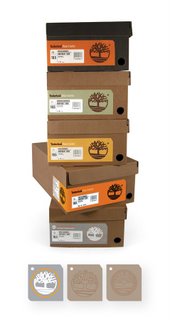Timberland's Environmental Labeling
The folks at Timberland are taking a step forward (get it -- shoe makers... taking a step forward... aw, never mind...) towards greater transparency by placing information about the shoe's figurative footprint right on the box. The "Our Footprint" label includes three sections:I like it. The Environmental Impact is similar to the Acres and Gallons labeling idea I had earlier. I think it would also be good if they would publish how many acres of land it took to raise the cattle which contributed the leather. I like how Timberland is creating this on their own, but it would be even better if the rest of the shoe industry followed their lead so you could compare between shoe makers on these environmental and social issues.
- "Environmental Impact" reports the average number of kWh kilowatt-hours that are used to produce a pair of Timberland shoes and the percentage of renewable energy Timberland uses from sources such as the sun, wind and water. Total energy use (measured in kWh and obtained from each factory's utility bills) is divided by footwear production. Each factory gets assigned a weight according to the percent production they do for Timberland. The weighted factory scores are then averaged to produce an average kWh (or energy use) per pair.
- "Community Impact" details the percentage of factories assessed by Timberland against its Code of Conduct, the percentage of child laborers in factories' workforce and the total number of hours Timberland employees volunteered in the previous year.
- "Manufactured" tells in what factory and what country the product was made.
The "nutrition label" will be placed on greener boxes made from 100% post-consumer recycled fiber with soy-based inks and water-based solvents. The company's not stopping there, though. They plan to adopt the "Our Footprint" label for apparel, and are also developing a Green Index (which they compare to an Energy Star rating) for measuring their shoes' environmental impact in terms of climate, chemical use and material use.
via sustainablog






No comments:
Post a Comment
Note: Only a member of this blog may post a comment.